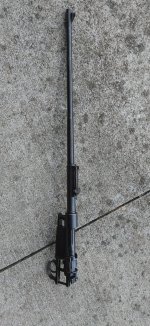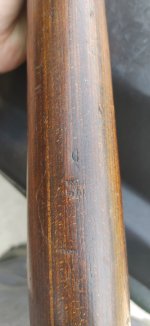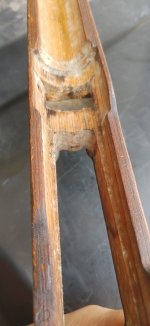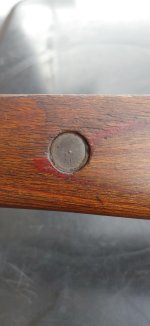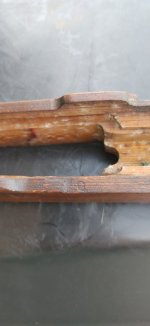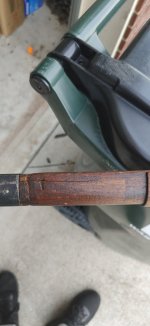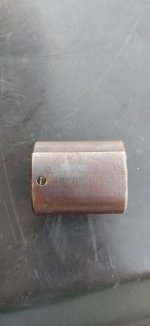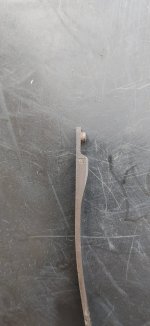this is an interesting variant. We discussed one earlier this past year. What's interesting is DUV obviously gave up receiver production as they were switching over to G41 full time production.
The last few blocks of duv production show up with bcd41 receivers and this connection is Astrawerke who made these bcd marked receivers and obviously has these duv 42 receivers on hand or were being made then not needed and sent to Gustloff. So we have duv rifles with bcd receivers and duv rifles with bcd41 receivers.
Its the little things like this that really drove early collectors nuts and confused now things we like to own cause they are different.
Thank you, you mention some very important things.
This is one of the important topics, and this puzzle can only be solved if you study Berlin-Lübecker Maschinenfabrik and Gustloff-Werke intensively. I have been working on this topic since 2016 and often thought that I was very close to finding the answer. I have done serial number studies, which I learned here on the forum from historians like Paul Shomper and many helpful collectors with their data. A major problem is that the records from that time are incomplete and many documents have been destroyed. Thanks to the documents that have been preserved, many answers have been found in the past, but there are still some gaps in our knowledge. By the way, in most cases, the collectors assumptions and serial number studies were extremely close to reality.
I collected and studied the stock completion date codes and in many cases I was able to narrow down the time periods. Basically I used the "Shomper-System" again and that was the only way I was able to find more answers. As with barrel codes, stock completion date codes are often linear and very important. However, this is not always the case due to production interruptions and other reasons and this is important to note.
In 2016, I knew some documents, but often only part of a correspondence and therefore it is difficult or even impossible to draw really reliable conclusions from them. The context is usually hidden and must be found. I am not Raymond Babbitt, so I had to find a way to organize thousands of documents in order to draw important conclusions from them. Again I used the "Shomper-System" and just as I had entered the data from the K98k serial number study into excel spreadsheets, I did the same now with the documents. The documents are sorted by date, the content is noted in brief, as well as the context and historical links. Furthermore, I have almost all documents with the records of the discussion points at the Führer meetings between February 1942 and March 1945, in which the decisions of Adolf Hitler and the armaments minister Albert Speer are recorded. The Reich Ministry for Armaments and Munitions had its own newsletter with important laws and instructions in the armaments industry. The individual magazines from June 1943 to January 1945 are almost complete. I have also sorted these in the same way. I compare these data with each other, therefore I get some new answers.
My work is not better than that of others, I just continue it and refine some things. I am impressed by the "old collectors" and the difficult ways they had to gather information and create all the basic knowledge that we can work with today. I already had the advantage of the internet and I could find information quickly. One of the most important advantages I had was that German is my native language and therefore I can read between the lines in documents. If the "old collectors" had all spoken German and had the documents available that we have today, then they would certainly have solved all the mysteries already. Actually, I have no reason to continue my work, I'm not a collector and I'm only doing it to help Bruce and Mike with their book. As long as I see that you are still interested, I will try to continue my work and finish it.
The Gustloff-Werke and Berlin-Lübecker Maschinenfabrik connection, regarding the Astrawerke receiver, in an abbreviated version:
In 1942, the German armaments industry already had many problems and the transition to a new weapon was a major challenge. One of the main problems in such a case was that it reduced the overall output of weapons. This shortfall in the number of rifles had to be compensated for, which is why a second assembly line was put into operation.
While one assembly line or shift shuts down and stops the assembly of the K98k and switches the machines over to a new weapon, such as the G.41, the second assembly line continues to assemble K98k. In this way, the shortfall should be completely compensated for, or at least reduced. The troops needed every rifle. The first assembly line had shut down, and in December 1942 only 6,411 K98k were accepted by the Waffenamt team 214 in Lübeck. This ended in the "k" block with "duv42" coded receivers. The second assembly line used the following receivers:
"duv41" Berlin-Lübecker Maschinefabrik inhouse receiver
"duv41" Astrawerke receiver
"bcd41" Astrawerke receiver
The same thing was done with Gustloff-Werke, therefore this strange-seeming swap of receivers. This use of different codes was planned and intentional.
A very good example of such a transition can be found in the Volume II book in the first chapter on page 40/41. Be sure to read the text and look at the document, the details are important.
Instead of "Hitler's Garands" there would have been less flattering comments at the time. In February 1943 the Waffenamt communicated very clearly what a disaster the G.41 rifle represented for overall rifle production.
 0f4d8bde-92cf-4236-9008-b17b14a3719cphoto.jpeg130.6 KB · Views: 51
0f4d8bde-92cf-4236-9008-b17b14a3719cphoto.jpeg130.6 KB · Views: 51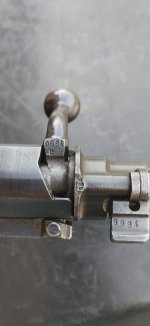 8f66f3f4-a0b7-48b7-8f4a-0f373c2921e6photo.jpeg111.6 KB · Views: 53
8f66f3f4-a0b7-48b7-8f4a-0f373c2921e6photo.jpeg111.6 KB · Views: 53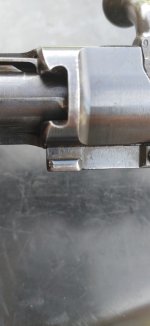 2ddf99ca-f6c7-49c8-9411-67891eb0d9e8photo.jpeg100.3 KB · Views: 49
2ddf99ca-f6c7-49c8-9411-67891eb0d9e8photo.jpeg100.3 KB · Views: 49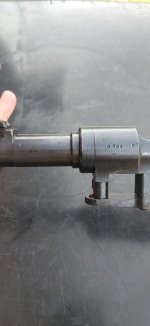 d8eb2ca9-b534-4482-a4bb-fb6e6b9306f9photo.jpeg109.6 KB · Views: 46
d8eb2ca9-b534-4482-a4bb-fb6e6b9306f9photo.jpeg109.6 KB · Views: 46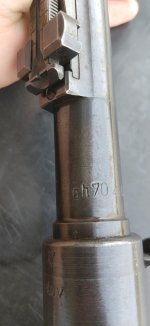 c474c98e-84a9-408c-9916-ef6babc6756aphoto.jpeg132.4 KB · Views: 44
c474c98e-84a9-408c-9916-ef6babc6756aphoto.jpeg132.4 KB · Views: 44 9f6e9ede-c3f3-4f2b-b9c6-3a144400c705photo.jpeg123.6 KB · Views: 38
9f6e9ede-c3f3-4f2b-b9c6-3a144400c705photo.jpeg123.6 KB · Views: 38 e541b3fe-6416-4728-8d25-bf908da747baphoto.jpeg116.9 KB · Views: 38
e541b3fe-6416-4728-8d25-bf908da747baphoto.jpeg116.9 KB · Views: 38 287793e7-cd4b-470f-97c7-06e925c7e284photo.jpeg123.2 KB · Views: 37
287793e7-cd4b-470f-97c7-06e925c7e284photo.jpeg123.2 KB · Views: 37 23400625-49a1-498b-aed9-2bde41563424photo.jpeg141.8 KB · Views: 34
23400625-49a1-498b-aed9-2bde41563424photo.jpeg141.8 KB · Views: 34 a72f6d62-3c69-424d-9532-75e43a4b5b24photo.jpeg112.1 KB · Views: 34
a72f6d62-3c69-424d-9532-75e43a4b5b24photo.jpeg112.1 KB · Views: 34 e363defe-f62a-44a9-acd7-39d8177f2993photo.jpeg135.3 KB · Views: 36
e363defe-f62a-44a9-acd7-39d8177f2993photo.jpeg135.3 KB · Views: 36 f6e31847-9d99-4535-a9e3-228060e920abphoto.jpeg172.2 KB · Views: 35
f6e31847-9d99-4535-a9e3-228060e920abphoto.jpeg172.2 KB · Views: 35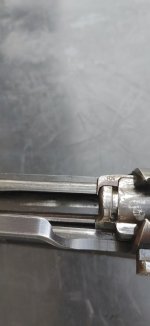 74e33ad8-50f0-430c-b246-f5f00ae16937photo.jpeg99.8 KB · Views: 35
74e33ad8-50f0-430c-b246-f5f00ae16937photo.jpeg99.8 KB · Views: 35 aeb2a3db-da87-46bd-9bb4-c48ce076607fphoto.jpeg137.4 KB · Views: 31
aeb2a3db-da87-46bd-9bb4-c48ce076607fphoto.jpeg137.4 KB · Views: 31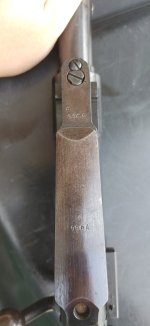 69de428b-6b3e-409c-a44c-1ceb863ba7b4photo.jpeg117.2 KB · Views: 44
69de428b-6b3e-409c-a44c-1ceb863ba7b4photo.jpeg117.2 KB · Views: 44





